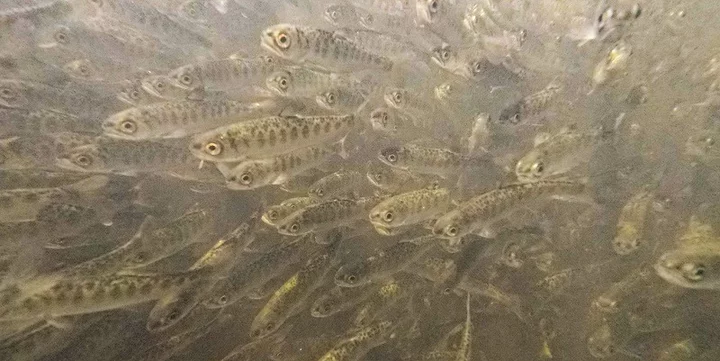Photo via CDFW.
###
PREVIOUSLY: ‘These Baby Fish Represent Hope’: CDFW Releases 500,000 Juvenile Salmon into Klamath River
###
Press release from the California Department of Fish and Wildlife:
The California Department of Fish and Wildlife (CDFW) this week successfully completed the release of more than 2 million fall-run Chinook salmon smolts into the Klamath River.
On Wednesday, May 15, CDFW released approximately 1.3 million fall-run Chinook salmon smolts below the Iron Gate Dam and carried out another release of approximately 800,000 fish from the same location on Wednesday, May 22.
The salmon smolts were trucked about 7 miles to the release point from CDFW’s new, state-of-the-art Fall Creek Fish Hatchery. The fish carried coded-wire tags and had their adipose fins clipped to later identify them as being of hatchery origin and provide scientists and hatchery managers with data about their life histories and the success of the release.
Although still undergoing the final phases of construction, CDFW’s new Fall Creek Fish Hatchery, which replaces the 63-year-old Iron Gate Fish Hatchery on the Klamath River, has already exceeded its production goal of 3.25 million salmon in its first year of operation, the combined result of the excellent water quality in Fall Creek, a tributary to the Klamath River, along with improved efficiencies of the facility itself.
The salmon smolts are about six months old and average just under 3 inches in length. The smolt releases began earlier than scheduled last week due to warming temperatures in the Klamath Basin and C. Shasta disease concerns. C. Shasta – or Ceratonova shasta – is a naturally occurring freshwater parasite native to the Klamath River that can cause disease in young salmon. The fish are particularly susceptible in warmer water temperatures. Those concerns were alleviated this week, however, with a return of cooler temperatures to the Klamath Basin.
Dam removal provided a dramatic backdrop to CDFW’s salmon releases. The three remaining Klamath River dams targeted for removal – JC Boyle, Copco 1 and Iron Gate – are all being actively deconstructed. Their removal is ahead of schedule and could open up free fish passage and access to hundreds of miles of new spawning and rearing habitat to salmon returning from the ocean as early as this fall.
CDFW plans another release of 250,000 to 300,000 yearling fall-run Chinook salmon later this year. If dam removal proceeds at its current pace, CDFW expects to release the fish directly from its Fall Creek Fish Hatchery into Fall Creek, which has been inaccessible to salmon due to its location behind the Iron Gate Dam.
Dam removal, the transition to the state-of-the-art Fall Creek Fish Hatchery, increasing variability in hatchery releases at different salmon life stages to supplement in-river production and the strong relationships forged with tribal partners that have made these actions successful are all critical components of the California Salmon Strategy for a Hotter, Drier Future released by Gov. Gavin Newsom in January 2024.

CLICK TO MANAGE